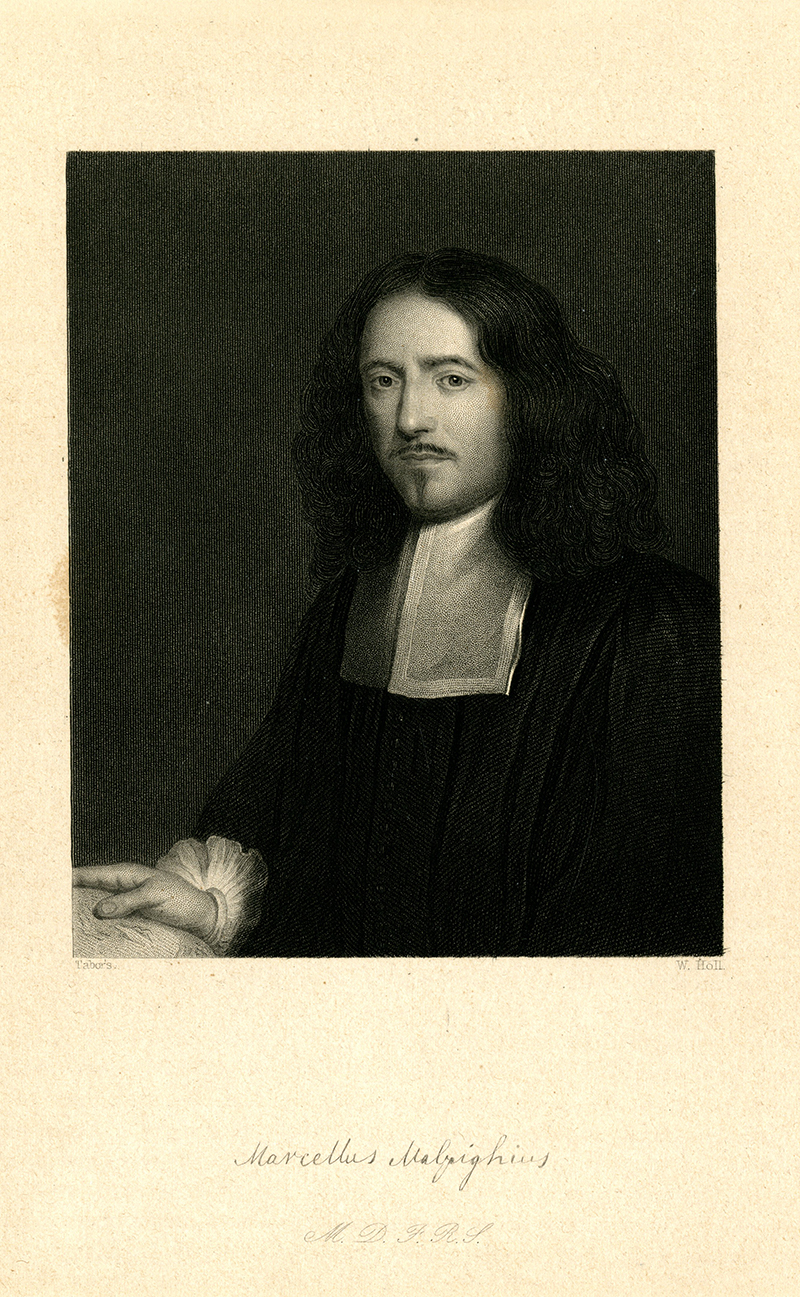Opera omnia. 2nd Edition. 2 vols. in 1. Leiden: Apud Petrum Vander Aa, 1687.
 Marcello Malpighi was born in Bologna, Italy and studied medicine and philosophy in his home town at the University of Bologna. He became a professor at this same school and then at the University of Pisa and the University of Messina. He was also physician to Pope Innocent XII. In Pisa, Malpighi was associated with Giovanni Alfonso Borelli, a professor of mathematics who was very influential to him. In fact, Malpighi’s famous work, De pulmonibus (1661), was originally written in the form of letters to Borelli. Later, however, their relationship disintegrated and Malpighi sustained many attacks from his former friend, and from those involved in a separate family feud. These attacks plagued his personal life, but in dealing with patients he continually showed sensitivity, gentleness and patience (Garrison 256). Some of his writings have been destroyed, but the remaining ones, which contribute greatly to the fields of medicine, anatomy and embryology, are the results of Malpighi’s pioneering histology investigations.
Marcello Malpighi was born in Bologna, Italy and studied medicine and philosophy in his home town at the University of Bologna. He became a professor at this same school and then at the University of Pisa and the University of Messina. He was also physician to Pope Innocent XII. In Pisa, Malpighi was associated with Giovanni Alfonso Borelli, a professor of mathematics who was very influential to him. In fact, Malpighi’s famous work, De pulmonibus (1661), was originally written in the form of letters to Borelli. Later, however, their relationship disintegrated and Malpighi sustained many attacks from his former friend, and from those involved in a separate family feud. These attacks plagued his personal life, but in dealing with patients he continually showed sensitivity, gentleness and patience (Garrison 256). Some of his writings have been destroyed, but the remaining ones, which contribute greatly to the fields of medicine, anatomy and embryology, are the results of Malpighi’s pioneering histology investigations.Known for being one of the first microscopists, Malpighi used the microscope in his study of the lungs, and it helped him identify capillary circulation in frogs. The discovery of the capillaries in the lungs, which finally completed William Harvey’s proof, shows how blood gets from the arteries to the veins. Probably his greatest contribution to the field of medicine, this finding put closure to the last real argument against Harvey (One Hund. Books 30). De pulmonibus,the work that reveals this path-breaking information, is included in the Reynolds-Finley Library’s edition of Opera omnia, a collection of Malpighi’s writings. But Malpighi also is recognized for his descriptions of chick embryology and silkworm and plant anatomy. His noteworthy works in these areas are included in the Opera omnia as well (Heirs of Hippocrates 372).
The Reynolds-Finley Library also has a first edition copy of De viscerum structura exercitation anatomica, which contains Malpighi’s classic essays on the structure of the kidney, spleen and the liver. These histological descriptions added much to the physiological knowledge of these organs. And in the process, he introduced the Malpighian bodies of the spleen and Malpighian layer of the skin (Not. Med. Books 73). Also in this work is the first description of Hodgkin’s disease (Garrison & Morton 535).
Clendening, Source Book of Med. Hist., p. 209; Garrison, Hist. of Med., 4th Edition, pp. 255-256; Garrison & Morton, Med. Bib., 5th Edition, 66 & 535; Heirs of Hippocrates, 372; Not. Med. Books, p. 73; One Hund. Books, 30; Reynolds Historical Library, Rare books and coll…, 2614.
Image: Marcello Malpighi, Print Collection, Reynolds-Finley Historical Library.
